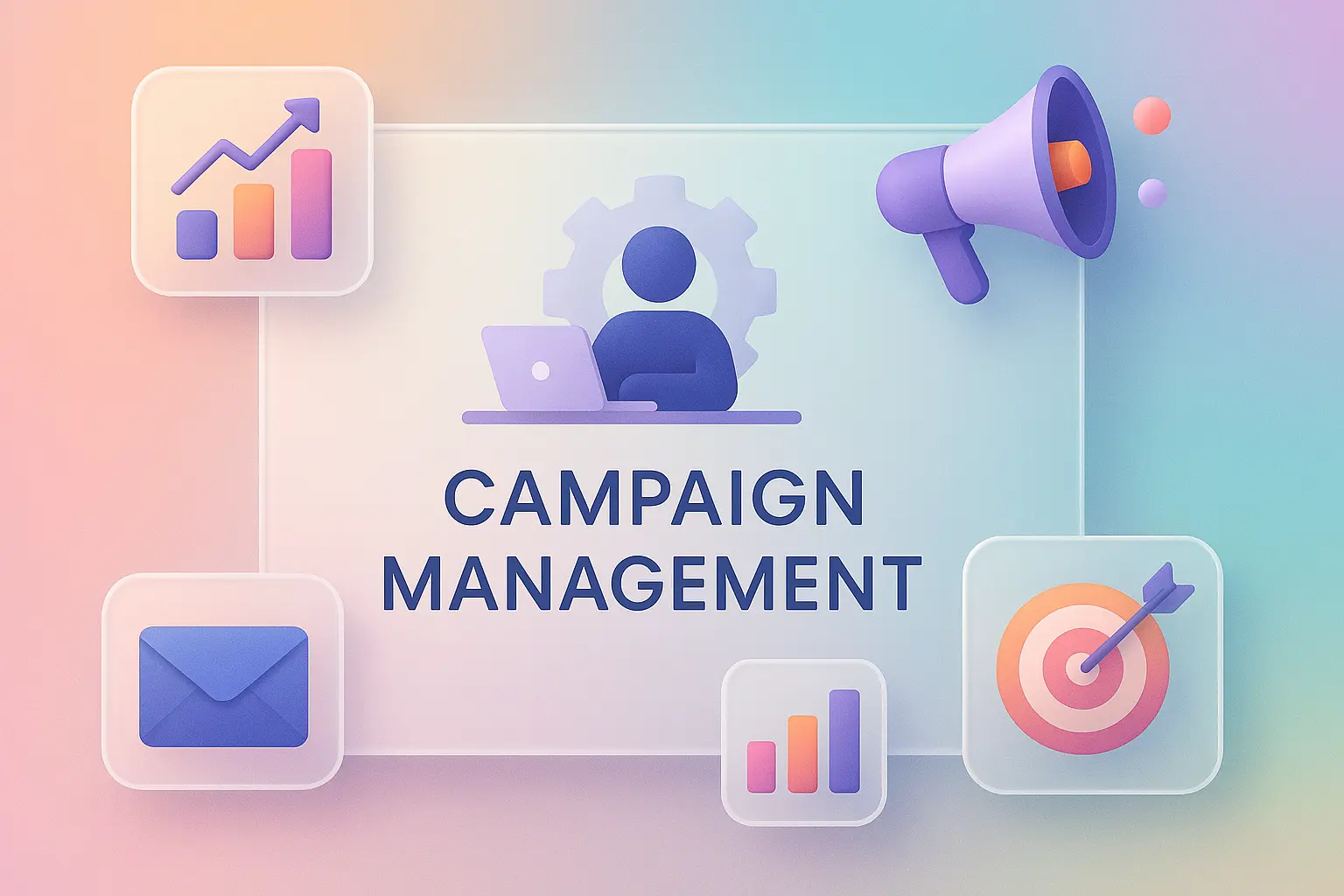Marketing Strategies: Definition, Types, and Examples
- July 4, 2023
- 18 mins read
- Listen

A well-crafted marketing strategy works like a roadmap for businesses to achieve success in a competitive market. It provides a direction to effectively reach the target audience and achieve the intended goals. A company that is driven by sound marketing strategies often has its goals, target message, and vision outlined well in advance.
When a business is run by a proper marketing strategy, it’s aware of the tactics to reach the target audience, optimize the budget, utilize the resources, and maximize results. It ensures that the business is guided by a clearly-developed strategy to adapt to the changing market conditions and consumer behavior.
More importantly, marketing strategies are key to making data-driven decisions by analyzing market trends, competitors, and customer feedback. It makes sure that the business has defined measurable objectives and KPIs to evaluate its marketing efforts.
In this post, we will explore marketing strategies in detail, and understand its definition, types, benefits, and key points for businesses.
But first, let’s get started with understanding what exactly are marketing strategies…
What is Marketing Strategy?
Marketing strategy refers to a set of actions and decisions that businesses take to achieve their goals and maximize their competitive advantage. It involves creating a broad plan to promote and market products and services effectively. From identifying target markets to understanding customer needs, a marketing strategy can involve many things that align the company’s goals with customer needs.
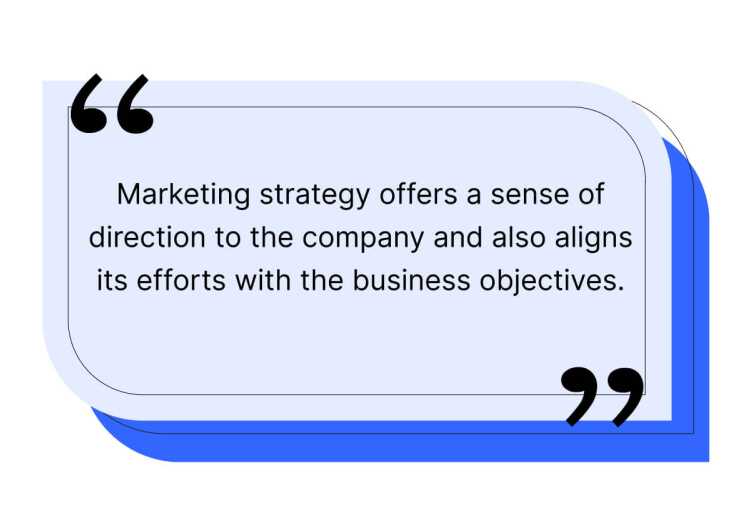
The purpose of devising and implementing a marketing strategy is to run the business based on a complete understanding of the market, and after identifying target segments and evaluating market trends. A business that has developed marketing strategies is able to tailor their resources and efforts more efficiently.
Why Does Marketing Strategy Matter?
A robust marketing strategy is essential for a business to successfully navigate the challenging and dynamic business environment. It helps in connecting with the target audience, leveraging market opportunities, and gaining a competitive advantage.
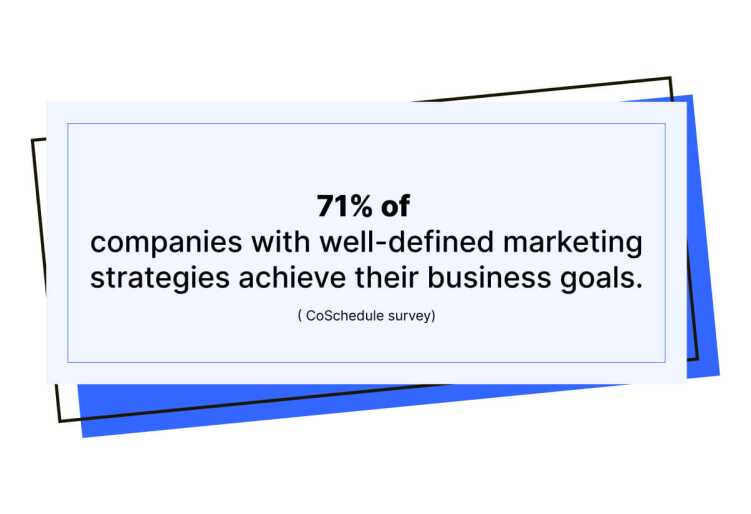
There are several reasons suggesting why marketing strategy matters –
- Marketing strategy offers a sense of direction to the company and also aligns its efforts with the business objectives.
- A business that runs by marketing strategies is able to better meet customer needs and achieve higher customer satisfaction.
- Having a well-defined marketing strategy ensures that the company is aware of the competitive landscape, understands the market well, and knows unique selling points.
- Products and services can be positioned effectively only when a business has developed a marketing strategy in advance.
- Resources can be invested wisely and in high-yield activities only when an organization has identified the target markets and marketing channels.
- When a market is analyzed and its trends are understood, it helps in identifying gaps in the market that can be leveraged to achieve success and growth.
- A competitive edge is gained when a business develops new products and adapts its marketing approach to suit the marketing opportunities.
The 5 Ps of Marketing Strategy
The 5 Ps of marketing strategy are key elements that a business needs to consider when creating a marketing plan. They work as a framework to develop and implement marketing strategies effectively. The 5 Ps are as follows:
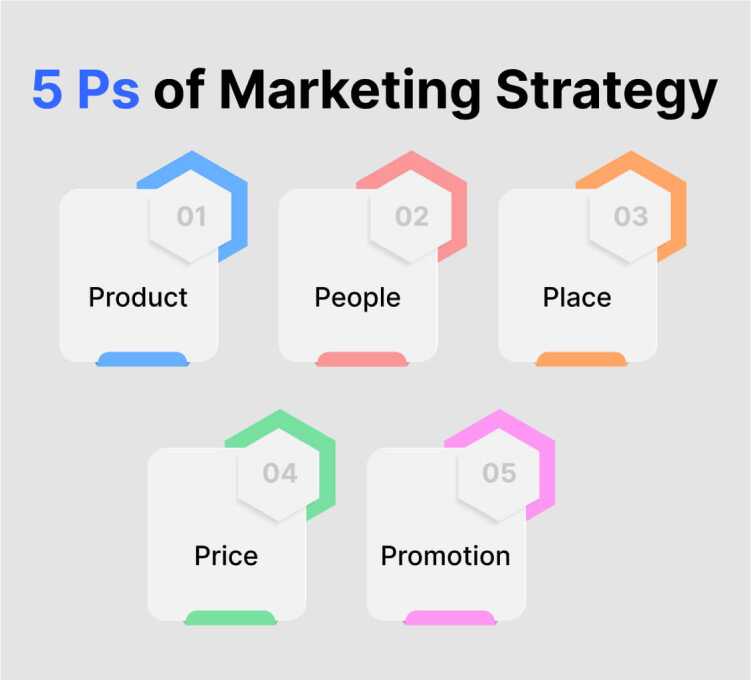
1. Product
All the decisions regarding product design, quality, features, packaging, and branding fall under this category. A business needs a solid product marketing strategy to position its products effectively and ensure value to buyers.
2. Price
The key to an effective pricing strategy is to determine the amount of money customers would love to pay for your products and services. All the pricing strategies in marketing, including the pricing models, discounts, etc. must consider key factors such as production cost, competitor pricing, and affordability. Together, these factors constitute effective price optimization that helps to maximize revenue.
3. Promotion
Promotion is a key part of full funnel marketing growth strategies as it involves analyzing and evaluating all the marketing and advertising activities that help promote the product to the target audience. A robust promotion strategy needs to be in sync with the brand positioning and the target market.
4. Place
The place is a vital element of the marketing mix that refers to the tactics, channels, and methods contributing to making the products available to customers. It involves all the decisions in regard to distribution channels so that the product reaches the target market in a convenient manner.
5. People
The “people” aspect of marketing strategy refers to all the individuals who interact and engage with the target audience and contribute to the delivery of a product or service. It focuses on the importance of customer service and interactions.
Types of Marketing Strategies
A business can build brand awareness, promote its products or services and engage with its target audience using one of several types of digital marketing strategies. The selection of the right strategy will depend on the business objective and marketing goals.
Here are popular forms of online marketing strategies –
Content Marketing Strategy
The form of marketing that is driven by content is called content marketing. This marketing is concerned with creating and distributing information and value-addition content for customer engagement. Whether to interact, engage and delight the audience, content marketing can help achieve all the goals. Plus, content marketing costs 62% less yet generates three times as many leads as traditional outbound marketing.
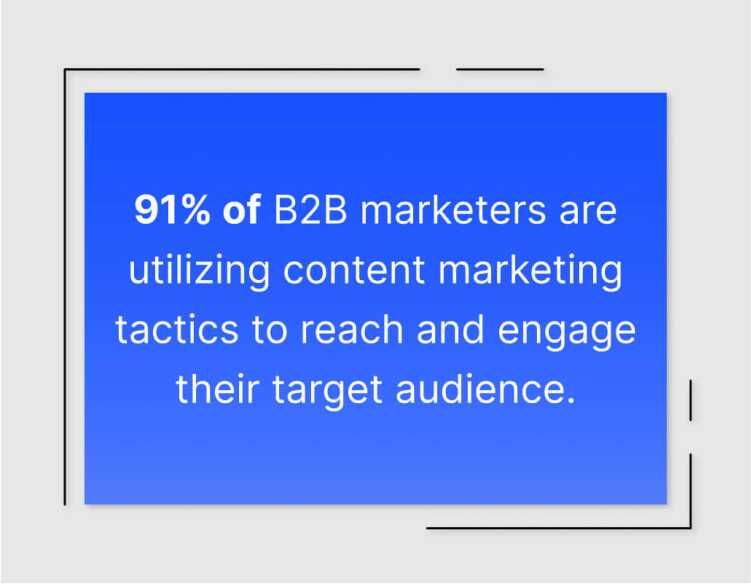
Some of the popular forms of content used include blog posts, articles, e-books, videos, visual guides, and more. These content types are strategically used to build brand authority and nurture relationships with customers. The use of content is also done to create thought leadership in the industry.
Email Marketing Strategy
Email continues to be a dominant tool for marketing. Using the power of email, a business can send targeted messages to a select group of subscribers and make their marketing more effective. Email marketing strategies are a great way to deliver personalized content and nurture leads. Brands can also use it to promote offers and build loyalty.
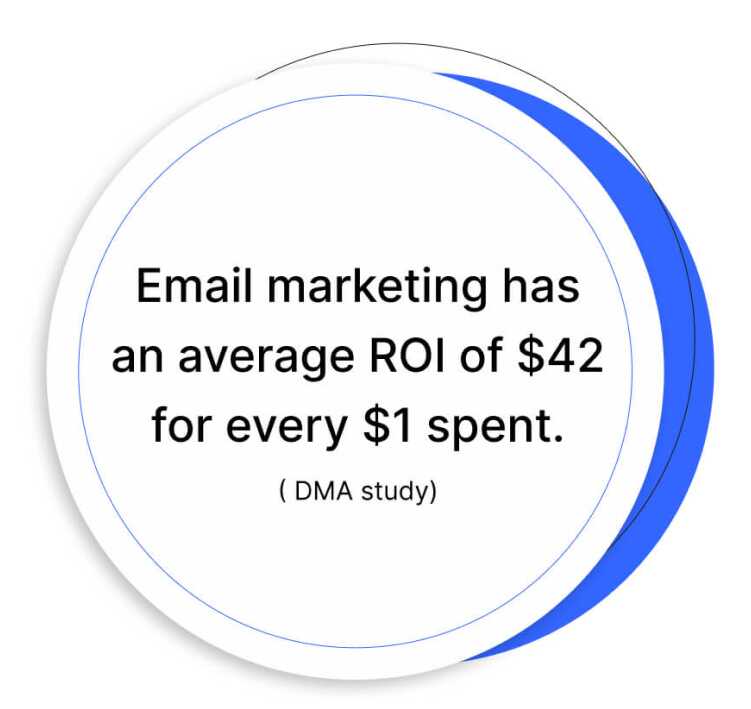
More so, email campaigns can be launched to send newsletters, provide product updates, etc. Plus, this form of marketing is so effective that as many as 69 percent of marketers use email marketing to disseminate their content.
Search Engine Marketing (SEM) Strategy
Search engines have been among the most dominant marketing channels for brand promotion. Brands use paid ads to appear on the top pages of search engines. Doing this can improve their visibility notches up and bring them in front of the target audience. One of the key highlights of search engine marketing is to drive targeted traffic and achieve immediate visibility. You can use strategies for Facebook marketing and Instagram and leverage the vast potential of social platforms.
Affiliate Marketing Strategy
Businesses have long been leveraging the reach and marketing efforts of affiliates to expand their reach and customer base. This form of marketing is about partnering with an affiliate/s with the view to getting wider coverage for the products and services. In affiliate marketing, the collaboration is based on the payment on each sale or each lead generated by the affiliate for the business.
Social Media Marketing Strategy
Over the years, social media channels have grown a lot, becoming a key avenue for brands to market their brand and engage with the audience. These channels provide a great platform to connect and interact with customers, both potential and existing and achieve marketing targets easily.
Using social media marketing strategies, a business can create and share content with a global audience too, without spending much. Targeted ads can also be run to attract the audience. More so, followers can be interacted with to promote the offers and solve their issues, if any.
A comprehensive social media marketing strategy often involves these three channels –
- Facebook Marketing Strategy – Facebook is the most popular and most widely used social platform in the world with over 3 billion daily active users. So, it has obviously been a top choice for brands to market their products and service on Facebook and boost engagement and conversion. The purpose of devising a Facebook marketing strategy is to promote your business on Facebook to build brand awareness, gather leads and sell more products and services.
- Instagram Marketing Strategy – Instagram is a popular platform with over 1 billion monthly active users. This gives businesses a great opportunity to leverage this platform and connect with a large audience. The visual nature of this platform helps in showcasing products and services through compelling images and videos. Higher engagement rates are a top reason why brands devise marketing strategies for Instagram and build brand awareness.
- LinkedIn Marketing Strategy – LinkedIn is the most trusted platform for connecting and networking with professionals, industry peers, partners, and influencers. As a professional social networking site, it gives great opportunities for business development and lead generation. Companies often devise robust LinkedIn marketing strategies to build relationships and target the audience based on various professional attributes.
Learn more: 15 WhatsApp Marketing Strategies for Your Business
Effective Marketing Strategies for Small Businesses
There was a time when small businesses found it hard to compete with the might of big enterprises, but any anymore. The changing landscape of marketing strategies, coupled with the arrival of online avenues, has ensured a label-playing field. Today, small businesses have a variety of marketing strategies to benefit as much as their counterpart.
Here are some of the key marketing strategies that small businesses could use –
1. Local Marketing
For small businesses, local marketing is among the best approaches to understanding and engaging with their local community. It helps in building a lasting relationship with the target audience and connecting with the immediate community.
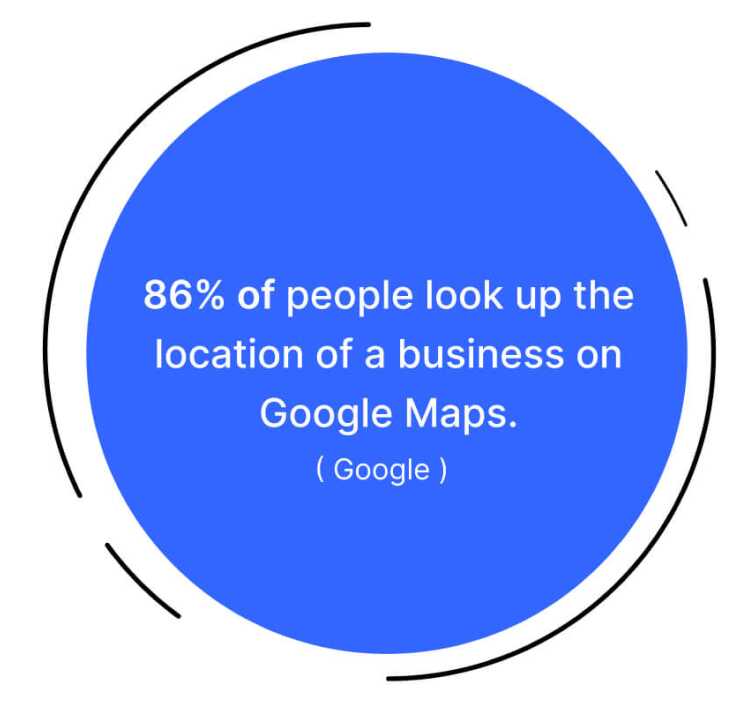
Key Strategies
- Collaboration with other local businesses, doing cross-promotions, and utilizing each other’s customer base is key to a successful marketing strategy.
- List the business on popular online directories such as Yellow Pages, Google My Business, etc as it will improve the visibility in local searches.
- Benefit from local SEO by using location-specific keywords in your website content, URLs, and meta tags as it will improve local search rankings.
2. Referral Marketing
Referral marketing is based on the foundation of leveraging the existing customer base to gain new ones. It uses the assumption that satisfied customers could be a great driver for new business. With a well-crafted referral marketing program, a business can maximize its existing customer base and drive the growth of your business without much investment.
Key Strategies
- Offer incentives to customers so that they show a willingness to refer your business to others.
- Design a proper referral program and show how to make the referral and how to earn the awards.
- Promote your referral program and highlight its benefits so that more of your customers feel encouraged and inspired to join it.
- Maintain a strong bond with your loyal customers, engage with them, and nurture the relationships as some of them will surely refer your business to others.
3. Online Marketing
Online marketing is an umbrella term for a wide range of strategies that small businesses can employ for promotion on the Internet. Unlike traditional forms of marketing, it is cost-effective and measurable with the potential to boost visibility in a quick time. With well-rounded online marketing communication strategies, a small business could increase ROI and also achieve the desired growth.
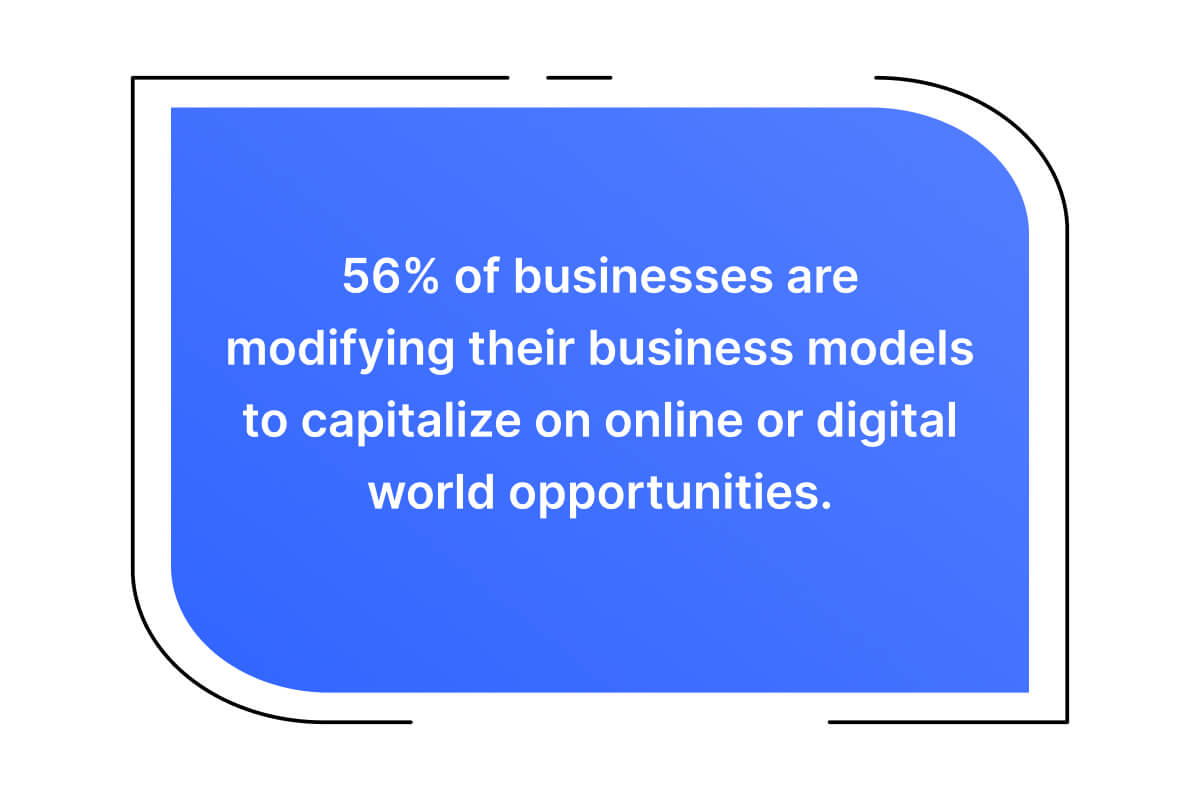
Key Strategies
- Create a user-friendly website to share your product information with potential customers and then optimize the site for SEO using relevant keywords.
- Create quality content and share it across channels to engage, entertain and inform customers.
- Utilize paid ads or PPC and make your business appear in top search engine results for specific keywords.
- Learn about marketing strategies of Facebook and other social channels to reach a wider audience.
- Leverage the established marketing strategies of Instagram to build brand awareness and drive traffic to your website.
4. Online Networking & Communities
Online networking and communities is a great marketing strategy for small businesses to build relationships, offer value and contribute to ongoing conversations. It’s a good way to form connections that can gradually pave the way for collaborations and a stronger network in the industry. The key is to join digital platforms and spaces where people and brands with shared interests connect and collaborate. Using these platforms, a small business can do knowledge sharing and build meaningful relationships.
Key Strategies
- Join relevant platforms like Reddit, Facebook, or LinkedIn to align with your niche and share insights with like-minded individuals.
- Focus on sharing valuable content and offering expertise as that can lead to business opportunities down the line.
- Contribute to relevant message boards and online forums with the view to positioning yourself or your business as an expert in the industry.
5. Public Relations (PR)
PR is a popular form of marketing strategy that small businesses often use to build brand awareness and boost credibility. The key to public relations is to engage with the target audience by having a well-defined message and leveraging target media outlets and influencers. More so, PR efforts can be combined with other forms of digital marketing strategies such as content and social media marketing strategies to develop an inclusive and holistic strategy.
Key Strategies
- Gain visibility and recognition through strategic media placements, press releases, and featured articles.
- Position yourself as an industry authority by using activities such as media interviews and expert commentary.
- Leverage the power of storytelling and craft engaging narratives that can connect with your target audience.
7 Steps of Marketing Strategy Process
A marketing strategy process involves seven steps that together can help your business develop an effective marketing strategy. By using these processes, you can devise a marketing strategy that not only aligns with your business goals but can also drive meaningful results.
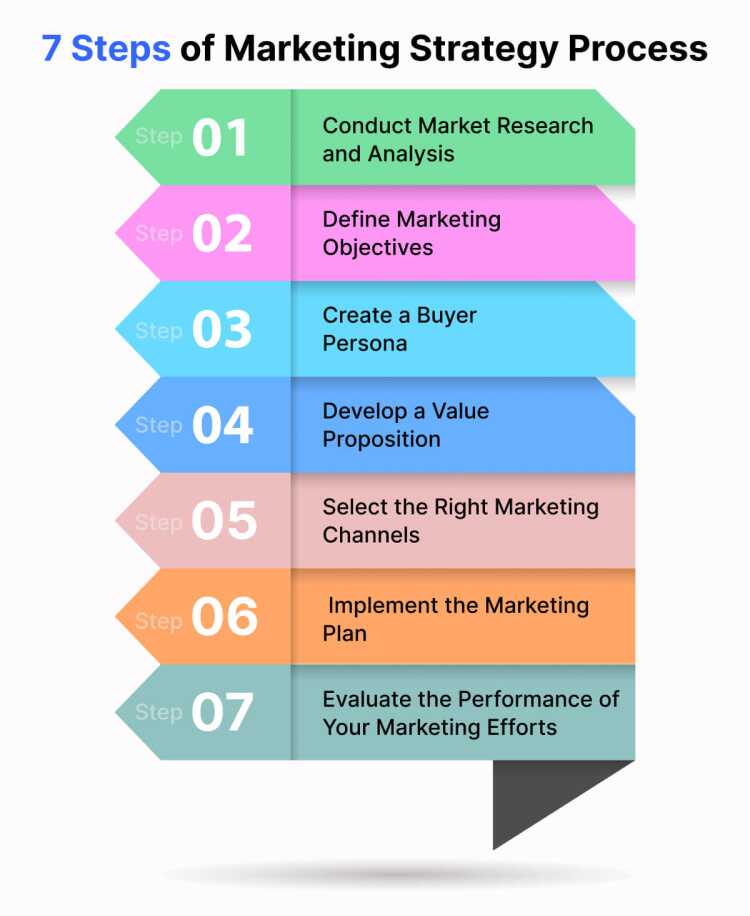
Here are the 7 steps of a marketing strategy process –
Step 1 – Conduct Market Research and Analysis
Conducting thorough market research and analysis is the starting point for creating a robust marketing strategy process for your business. This will help in understanding the industry and market trends better. You can also gain a deep insight into customer behavior and competitor when you carry out market research. The key purpose behind this research and analysis is to collect data on your target audience and be aware of their needs, pain points, and preferences. Unless you do market research, you can’t make informed decisions in the later stages of the marketing strategy process.
Step 2 – Define Marketing Objectives
The data and insights gained from the market research should be used in defining your marketing objectives and goals for the business. The goals should be SMART ( Specific, Measurable, Achievable, Relevant, and Time-Bound ) so that your employees feel inspired to achieve them. If your marketing goals are aligned with your business objectives, it will always ensure growth and success for the organization.
Step 3 – Create a Buyer Persona
Creating a buyer persona is key to tailoring your marketing efforts and meeting the specific needs of your target audience. The purpose behind creating a buyer’s persona is to segment your audience so that you can run more personalized marketing campaigns. When you segment the audience based on their needs, behaviors, and characteristics, you’re basically taking a solid step toward making your marketing campaigns more effective.
Step 4 – Develop a Value Proposition
A business whose products or services are unique is more likely to stand out in the market compared to others. It’s the USP of your offerings that will differentiate your brand from competitors. For that reason, you should develop a value proposition to appeal to your target audience. The purpose behind developing a value addition is to highlight the unique benefits you intend to provide to customers.
Step 5 – Select the Right Marketing Channels
The marketing strategy process you devise should help you reach and engage your audience better. This is only possible when you choose the right marketing channels that fit well into your business goals and objectives. The right approach is to consider both digital and conventional channels such as paid ads, SEO, email, social media, events, etc. to better market your products across customer segments or categories.
Step 6 – Implement the Marketing Plan
Now when the channels are selected, the next step in the marketing strategy process is to implement the market plan and execute all the planned activities and campaigns. From creating content to setting up ad campaigns, make sure your marketing plan is up and running, and is also consistent across channels. By implementing your marketing plan, you will put into action all the activities that you have envisaged and visualized to reach and engage your target audience.
Step 7 – Evaluate the Performance of Your Marketing Efforts
Most of your marketing efforts are measurable, so you can track key metrics by using quality analytics tools. A performance evaluation against the defined KPIs will give insights into vital metrics such as conversion rates, engagement, traffic, and ROI. Since you will have loads of customer-centric data, you can always analyze the areas of improvement and optimize the marketing strategy for better results.
Marketing Strategy Examples
No two businesses are alike, and so do the marketing tactics employed by them. What works best may not suit the other and vice versa. But still, there are some great marketing strategy examples of small businesses that defined the norm and set a precedent for others.
Some examples include –
1. The Green Thumb Nursery – Utilizing the Power of Local Marketing
The Green Thumb Nursery, South California, showed how to make the best use of local marketing strategies for branding. It first organized gardening workshops and community events and then advertised these events through the nearby neighborhoods. In addition, the nursery went a step ahead and formed partnerships with nearby restaurants and cafes to showcase their flowers and plants. Apart from using local SEO and Google My Business, it also introduced a well-devised customer loyalty program to reward repeat customers. By combining a variety of local marketing activities, the nursery not only gained a loyal customer base but also boosted its reputation in the area.
2. Red Bull – Benefiting from a Strong Content Marketing Strategy
Energy drink company Red Bull is a great example of how to engage with the audience through a unique content strategy. It has leveraged the power of content to build a strong brand presence and drive sales. The first big decision the company took was to create its own media division for producing and distributing content across various platforms. In addition, it established a content pool that offers a centralized platform for content creators to access and use its library of high-quality visual content. The best strategy it adopted was to integrate the brand into various events and competitions and boost engagement.
3. GoPro – Leveraging the Power of User-Generated Content
GoPro is a great example of how a company can strengthen its marketing strategy with user-generated content. It leverages the passion and creativity of its users to create an engaging marketing campaign that showcases the unique experiences made possible by its GoPro cameras. The campaign not only shows the amazing capabilities of the product but also helps engage with the target audience.
4. Sephora – Maximizing the Potential of Loyalty Programs
Sephora is a popular beauty retailer whose successful marketing strategy around loyalty programs stands out for various reasons. The program offers personalized experiences and, exclusive benefits to its members. The purpose behind this unique marketing strategy is to build a sense of community with its customers, nurture customer loyalty, and increase customer retention. Its loyalty programs have a tiered approach and ensure generous rewards and plenty of incentives for users to show loyalty.
Final Thoughts
Marketing strategies have always been the pillar upon which brands write their scrip of success. They are the driving force for improving engagement and building brand awareness. With so many different types of channels and strategies available for marketing, the key is to use, and combine, the ones that fit well into the business goals.
With REVE Chat, you find a variety of tools to boost your customer engagement and automate tasks across marketing and sales.
You can sign up here and check tools for customer engagement.




